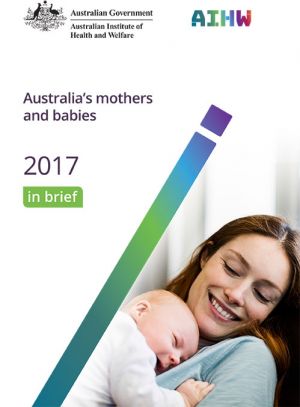Australia’s mothers and babies 2017: Difference between revisions
From Embryology
mNo edit summary |
mNo edit summary |
||
| Line 1: | Line 1: | ||
{{Header}} | |||
== Introduction == | |||
[[File:Australia's mothers and babies 2017.jpg|thumb|alt=Australia's mothers and babies 2017|link=Australia’s mothers and babies 2017|Australia's mothers and babies 2017]] | [[File:Australia's mothers and babies 2017.jpg|thumb|alt=Australia's mothers and babies 2017|link=Australia’s mothers and babies 2017|Australia's mothers and babies 2017]] | ||
[https://www.aihw.gov.au/reports/mothers-babies/australias-mothers-and-babies-2017-in-brief/contents/table-of-contents Australia's mothers and babies 2017—in brief] [27 June 2019]<ref name=AMB2017>{{Ref-AMB2017}}</ref> | [https://www.aihw.gov.au/reports/mothers-babies/australias-mothers-and-babies-2017-in-brief/contents/table-of-contents Australia's mothers and babies 2017—in brief] [27 June 2019]<ref name=AMB2017>{{Ref-AMB2017}}</ref> | ||
| Line 11: | Line 13: | ||
* Explore the characteristics and health of mothers and their babies through interactive data visualisations, including in-depth information and trends on the antenatal period, labour, birth and babies outcomes at birth. | * Explore the characteristics and health of mothers and their babies through interactive data visualisations, including in-depth information and trends on the antenatal period, labour, birth and babies outcomes at birth. | ||
<br> | |||
{{Australia mothers and babies links}} | |||
<br> | |||
{{Birth Links}} | |||
Revision as of 15:23, 27 June 2019
| Embryology - 18 Apr 2024 |
|---|
| Google Translate - select your language from the list shown below (this will open a new external page) |
|
العربية | català | 中文 | 中國傳統的 | français | Deutsche | עִברִית | हिंदी | bahasa Indonesia | italiano | 日本語 | 한국어 | မြန်မာ | Pilipino | Polskie | português | ਪੰਜਾਬੀ ਦੇ | Română | русский | Español | Swahili | Svensk | ไทย | Türkçe | اردو | ייִדיש | Tiếng Việt These external translations are automated and may not be accurate. (More? About Translations) |
Introduction
Australia's mothers and babies 2017—in brief [27 June 2019][1]
- In 2017, 301,095 women gave birth in Australia, an increase of 4.0% since 2007.
- 13% of women who gave birth in 2017 had gestational diabetes
- 1 in 3 mothers had a caesarean section in 2017
- 6.7% of liveborn babies were low birthweight in 2017
Australia's mothers and babies data visualisations [27 June 2019]
- Explore the characteristics and health of mothers and their babies through interactive data visualisations, including in-depth information and trends on the antenatal period, labour, birth and babies outcomes at birth.
| Australia’s mothers and babies: 2017 | 2016 | 2015 | 2014 | 2013 | 2012 | 2011 | 2010 | 2009 | 2008 | 2007 | National Perinatal Statistics Unit | AIHW | Australian Statistics | birth |
References
- ↑ Australian Institute of Health and Welfare 2019. Australia’s mothers and babies 2017—in brief. Perinatal statistics series no. 35. Cat. no. PER 100. Canberra: AIHW.
Cite this page: Hill, M.A. (2024, April 18) Embryology Australia’s mothers and babies 2017. Retrieved from https://embryology.med.unsw.edu.au/embryology/index.php/Australia%E2%80%99s_mothers_and_babies_2017
- © Dr Mark Hill 2024, UNSW Embryology ISBN: 978 0 7334 2609 4 - UNSW CRICOS Provider Code No. 00098G
